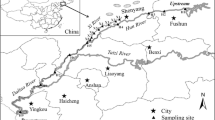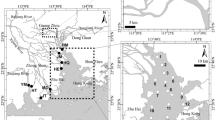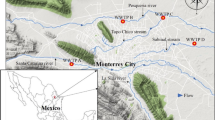Abstract
Studies on endocrine disruption in Australia have mainly focused on wastewater effluents. Limited knowledge exists regarding the relative contribution of different potential sources of endocrine active compounds (EACs) to the aquatic environment (e.g., pesticide run-off, animal farming operations, urban stormwater, industrial inputs). In this study, 73 river sites across mainland Australia were sampled quarterly for 1 year. Concentrations of 14 known EACs including natural and synthetic hormones and industrial compounds were quantified by chemical analysis. EACs were detected in 88 % of samples (250 of 285) with limits of quantification (LOQ) ranging from 0.05 to 20 ng/l. Bisphenol A (BPA; LOQ = 20 ng/l) was the most frequently detected EAC (66 %) and its predicted no-effect concentration (PNEC) was exceeded 24 times. The most common hormone was estrone, detected in 28 % of samples (LOQ = 1 ng/l), and the PNEC was also exceeded 24 times. 17α-Ethinylestradiol (LOQ = 0.05 ng/l) was detected in 10 % of samples at concentrations ranging from 0.05 to 0.17 ng/l. It was detected in many samples with no wastewater influence, and the PNEC was exceeded 13 times. In parallel to the chemical analysis, endocrine activity was assessed using a battery of CALUX bioassays. Estrogenic activity was detected in 19 % (53 of 285) of samples (LOQ = 0.1 ng/l 17β-estradiol equivalent; EEQ). Seven samples exhibited estrogenic activity (1–6.5 ng/l EEQ) greater than the PNEC for 17β-estradiol. Anti-progestagenic activity was detected in 16 % of samples (LOQ = 8 ng/l mifepristone equivalents; MifEQ), but the causative compounds are unknown. With several compounds and endocrine activity exceeding PNEC values, there is potential risk to the Australian freshwater ecosystems.




Similar content being viewed by others
References
Ahel M, Giger W, Schaffner C (1994) Behavior of alkylphenol polyethoxylate surfactants in the aquatic environment: 2. Occurance and transformation in rivers. Water Res 28:1143–1152
Allinson G, Allinson M, Shiraishi F, Salzman SA, Myers JH, Hermon KM, Theodoropoulos T (2008) Androgenic activity of effluent from forty-five municipal waste water treatment plants in Victoria, Australia. Environ Toxicol II 110:293–304
Allinson M, Shiraishi F, Salzman SA, Allinson G (2010) In vitro and immunological assessment of the estrogenic activity and concentrations of 17 beta-estradiol, estrone, and ethinyl estradiol in treated effluent from 45 wastewater treatment plants in Victoria, Australia. Arch Environ Contam Toxicol 58:576–586
Allinson M, Shiraishi F, Kamata R, Kageyama S, Nakajima D, Goto S, Allinson G (2011) A pilot study of the water quality of the Yarra River, Victoria, Australia, using in vitro techniques. Bull Environ Contam Toxicol 87:591–596
Anderson PD, Johnson AC, Pfeiffer D, Caldwell DJ, Hannah R, Mastrocco F, Sumpter JP, Williams RJ (2012) Endocrine disruption due to estrogens derived from humans predicted to be low in the majority of U.S. surface waters. Environ Toxicol Chem 31:1407–1415
Arditsoglou A, Voutsa D (2008) Determination of phenolic and steroid endocrine disrupting compounds in environmental matrices. Environ Sci Pollut Res 15:228–236
Bateman KP, Kellmann M, Muenster H, Papp R, Taylor L (2009) Quantitative–qualitative data acquisition using a benchtop Orbitrapo mass spectrometer. J Am Soc Mass Spectrom 20:1441–1450
Batty J, Lim R (1999) Morphological and reproductive characteristics of male mosquitofish (Gambusia affinis holbrooki) inhabiting sewage-contaminated waters in New South Wales, Australia. Arch Environ Contam Toxicol 36:301–307
Braga O, Smythe GA, Schafer AI, Feltz AJ (2005a) Fate of steroid estrogens in Australian inland and coastal wastewater treatment plants. Environ Sci Technol 39:3351–3358
Braga O, Smythe GA, Schafer AI, Feltz AJ (2005b) Steroid estrogens in primary and tertiary wastewater treatment plants. Water Sci Technol 52:273–278
Caldwell DJ, Mastrocco F, Anderson PD, Lange R, Sumpter JP (2012) Predicted-no-effect concentrations for the steroid estrogens estrone, 17 beta-estradiol, estriol, and 17 alpha-ethinylestradiol. Environ Toxicol Chem 31:1396–1406
Campbell C, Borglin S, Green F, Grayson A, Wozei E, Stringfellow W (2006) Biologically directed environmental monitoring, fate, and transport of estrogenic endocrine disrupting compounds in water: a review. Chemosphere 65:1265–1280
Celiz MD, Tso J, Aga DS (2009) Pharmaceutical metabolites in the environment: analytical challenges and ecological risks. Environ Toxicol Chem 28(12):2473–2484
Chapman H (2003) Removal of endocrine disruptors by tertiary treatments and constructed wetlands in subtropical Australia. Water Sci Technol 47:151–156
Chinathamby K, Allinson M, Shiraishi F, Lopata AL, Nugegoda D, Pettigrove V, Allinson G (2013) Screening for potential effects of endocrine-disrupting chemicals in peri-urban creeks and rivers in Melbourne, Australia using mosquitofish and recombinant receptor–reporter gene assays. Environ Sci Pollut Res 20:1831–1841
Cladiere M, Gasperi J, Lorgeoux C, Bonhomme C, Rocher V, Tassin B (2013) Alkylphenolic compounds and bisphenol A contamination within a heavily urbanized area: case study of Paris. Environ Sci Pollut Res 20:2973–2983
Coleman HM, Khan SJ, Watkins G, Stuetz RM (2008) Fate and analysis of endocrine disrupting chemicals in some sewage treatment plants in Australia. Water Sci Technol 58:2187–2194
Doyle CJ, Lim RP (2002) The effect of 17β-estradiol on the gonopodial development and sexual activity of Gambusia holbrooki. Environ Toxicol Chem 21:2719–2724
Doyle CJ, Lim RP (2005) Sexual behavior and impregnation success of adult male mosquitofish following exposure to 17 beta-estradiol. Ecotoxicol Environ Saf 61:392–397
Duong CN, Ra JS, Cho J, Kim SD, Choi HK, Park J-H, Kim KW, Inam E, Kim SD (2010) Estrogenic chemicals and estrogenicity in river waters of South Korea and seven Asian countries. Chemosphere 78:286–293
Eganhouse RP, Pontolillo J, Gaines RB, Frysinger GS, Gabriel FLP, Kohler H-PE, Giger W, Barber LB (2009) Isomer-specific determination of 4-nonylphenols using comprehensive two-dimensional gas chromatography/time-of-flight mass spectrometry. Environ Sci Technol 43:9306–9313
Environment Canada, Health Canada (2008) Screening assessment for the challenge phenol, 4,4′-(1-methylethylidene)bis-(bisphenol A). CAS 80-05-7, Ottawa
Fick J, Lindberg RH, Parkkonen J, Arvidsson B, Tysklind M, Larsson DGJ (2010) Therapeutic levels of levonorgestrel detected in blood plasma of fish: results from screening rainbow trout exposed to treated sewage effluents. Environ Sci Technol 44:2661–2666
Fromme H, Kuchler T, Otto T, Pilz K, Muller J, Wenzel A (2002) Occurrence of phthalates and bisphenol A and F in the environment. Water Res 36:1429–1438
Gadd J, Tremblay L, Northcott G (2010) Steroid estrogens, conjugated estrogens and estrogenic activity in farm dairy shed effluents. Environ Pollut 158:730–736
Game C, Gagnon MM, Webb D, Lim R (2006) Endocrine disruption in male mosquitofish (Gambusia holbrooki) inhabiting wetlands in Western Australia. Ecotoxicology 15:665–672
GWRC (2012) Bioanalytical tools to analyse hormonal activity in environmental waters: review of the state-of-the-science. Water Environment Research Foundation (WERF), Alexandria, VA, USA
Hotchkiss AK, Rider CV, Blystone CR, Wilson VS, Hartig PC, Ankley GT, Foster PM, Gray CL, Gray LE (2008) Fifteen years after "Wingspread" — environmental endocrine disrupters and human and wildlife health: where we are today and where we need to go. Toxicol Sci 105(2):235–259
Houtman CJ, Sterk SS, van de Heijning MP, Brouwer A, Stephany RW, van der Burg B, Sonneveld E (2009) Detection of anabolic androgenic steroid abuse in doping control using mammalian reporter gene bioassays. Anal Chim Acta 637:247–258
Howell WM, Black DA, Bortone SA (1980) Abnormal expression of secondary sex characters in a population of mosquitofish, Gambusia affinis holbrooki: evidence for environmentally-induced masculinization. Copeia 4:676–681
Jarosova B, Blaha L, Giesy JP, Hilscherova K (2013) What level of estrogenic activity determined by in vitro assays in municipal waste waters can be considered as safe? Environ Int 64C:98–109
Jobling S, Nolan M, Tyler CR, Brighty G, Sumpter JP (1998) Widespread sexual disruption in wild fish. Environ Sci Technol 32:2498–2506
Jobling S, Williams R, Johnson A, Taylor A, Gross-Sorokin M, Nolan M, Tyler CR, van Aerle R, Santos E, Brighty G (2006) Predicted exposures to steroid estrogens in UK rivers correlate with widespread sexual disruption in wild fish populations. Environ Health Perspect 114:32–39
Jobling S, Burn RW, Thorpe K, Williams R, Tyler C (2009) Statistical modeling suggests that antiandrogens in effluents from wastewater treatment works contribute to widespread sexual disruption in fish living in English rivers. Environ Health Perspect 117:797–802
Jondeau-Cabaton A, Soucasse A, Jamin EL, Creusot N, Grimaldi M, Jouanin I, Ait-Aissa S, Balaguer P, Debrauwer L, Zaiko D (2013) Characterization of endocrine disruptors from a complex matrix using estrogen receptor affinity columns and high performance liquid chromatrography-high resolution mass spectrometry. Environ Sci Pollut Res Int 20(5):2705–2720
Jürgens MD, Holthaus KIE, Johnson AC, Smith JJL, Hetheridge M, Williams RJ (2002) The potential for estradiol and ethinylestradiol degradation in English rivers. Environ Toxicol Chem 21:480–488
Khan SJ, Roser DJ, Davies CM, Peters GM, Stuetz RM, Tucker R, Ashbolt NJ (2008) Chemical contaminants in feedlot wastes: concentrations, effects and attenuation. Environ Int 34:839–859
Kidd KA, Blanchfield PJ, Mills KH, Palace VP, Evans RE, Lazorchak JM, Flick RW (2007) Collapse of a fish population after exposure to a synthetic estrogen. Proc Natl Acad Sci U S A 104:8897–8901
Kim YS, Katase T, Horii Y, Yamashita N, Makino M, Uchiyama T, Fujimoto Y, Inoue T (2005) Estrogen equivalent concentration of individual isomer-specific 4-nonylphenol in Ariake sea water, Japan. Mar Pollut Bull 51:850–856
Kolpin DW, Furlong ET, Meyer MT, Thurman EM, Zaugg SD, Barber LB, Buxton HT (2002) Pharmaceuticals, hormones, and other organic wastewater contaminants in U.S. streams, 1999–2000: a national reconnaissance. Environ Sci Technol 36:1202–1211
Kostich M, Flick R, Martinson J (2013) Comparing predicted estrogen concentrations with measurements in US waters. Environ Pollut 178:271–277
Kuster M, de Alda MJ, Hernando MD, Petrovic M, Martin-Alonso J, Barcelo D (2008) Analysis and occurrence of pharmaceuticals, estrogens, progestogens and polar pesticides in sewage treatment plant effluents, river water and drinking water in the Llobregat River basin (Barcelona, Spain). J Hydrol (Amst) 358:112–123
Legler J, van den Brink CE, Brouwer A, Murk AJ, van der Saag PT, Vethaak AD, van der Burg P (1999) Development of a stably transfected estrogen receptor-mediated luciferase reporter gene assay in the human T47D breast cancer cell line. Toxicol Sci 48:55–66
Legler J, Zeinstra LM, Schuitemaker F, Lanser PH, Bogerd J, Brouwer A, Vethaak AD, De Voogt P, Murk AJ, Van der Burg B (2002) Comparison of in vivo and in vitro reporter gene assays for short-term screening of estrogenic activity. Environ Sci Technol 36:4410–4415
Leusch FDL, Chapman HF, Körner W, Gooneratne SR, Tremblay LA (2005) Efficacy of an advanced sewage treatment plant in southeast Queensland, Australia, to remove estrogenic chemicals. Environ Sci Technol 39:5781–5786
Leusch FD, Chapman HF, van den Heuvel MR, Tan BL, Gooneratne SR, Tremblay LA (2006a) Bioassay-derived androgenic and estrogenic activity in municipal sewage in Australia and New Zealand. Ecotoxicol Environ Saf 65:403–411
Leusch FDL, Chapman HF, Kay GW, Gooneratne SR, Tremblay LA (2006b) Anal fin morphology and gonadal histopathology in mosquitofish (Gambusia holbrooki) exposed to treated municipal sewage effluent. Arch Environ Contam Toxicol 50:562–574
Leusch FDL, De Jager C, Levi Y, Lim R, Sacher F, Tremblay LA, Wilson VS, Chapman HF (2010) Comparison of five in vitro bioassays to measure estrogenic activity in environmental waters. Environ Sci Technol 44
Leusch F, Khan S, Gagnon M, Quayle P, Trinh T, Coleman H, Rawson C, Chapman H, Blair P, Nice H, Reitsema T (2014a) Assessment of wastewater and recycled water quality: a comparison of lines of evidence from in vitro, in vivo and chemical analyses. Water Res 50:420–431
Leusch FDL, Khan SJ, Laingam S, Prochazka E, Froscio S, Trinh T, Chapman HF, Humpage A (2014b) Assessment of the application of bioanalytical tools as surrogate measure of chemical contaminants in recycled water. Water Res 49:300–315
Li J, Chen M, Wang ZJ, Ma M, Peng XZ (2011) Analysis of environmental endocrine disrupting activities in wastewater treatment plant effluents using recombinant yeast assays incorporated with exogenous metabolic activation system. Biomed Environ Sci 24:132–139
Loos R, Carvalho R, António DC, Comero S, Locoro G, Tavazzi S, Paracchini B, Ghiani M, Lettieri T, Blaha L, Jarosova B, Voorspoels S, Servaes K, Haglund P, Fick J, Lindberg RH, Schwesig D, Gawlik BM (2013) EU-wide monitoring survey on emerging polar organic contaminants in wastewater treatment plant effluents. Water Res 47:6475–6487
Matthiessen P, Arnold D, Johnson AC, Pepper TJ, Pottinger TG, Pulman KGT (2006) Contamination of headwater streams in the United Kingdom by oestrogenic hormones from livestock farms. Sci Total Environ 367:616–630
McLachlan JA, Korach KS, Newbold RR, Degen GH (1984) Diethylstilbestrol and other estrogens in the environment. Fundam ApplToxicol 4:686–691
Ministry of the Environment in Japan (2009) substance: 4-n-octylphenol, Japan
Mispagel C, Shiraishi F, Allinson M, Allinson G (2005) Estrogenic activity of treated municipal effluent from seven sewage treatment plants in Victoria, Australia. Bull Environ Comtam Toxicol 74:853–856
Mispagel C, Allinson G, Allinson M, Shiraishi F, Nishikawa M, Moore MR (2009) Observations on the estrogenic activity and concentration of 17 beta-estradiol in the discharges of 12 wastewater treatment plants in Southern Australia. Arch Environ Contam Toxicol 56:631–637
Preuss TG, Gehrhardt J, Schirmer K, Coors A, Rubach M, Russ A, Jones PD, Giesy JP, Ratte HT (2006) Nonylphenol isomers differ in estrogenic activity. Environ Sci Technol 40:5147–5153
Rostowski P, Horwood J, Shears JA, Lange A, Oladapo FO, Besselink HT, Tyler CR, Hill EM (2011) Bioassay-directed identification of novel antiandrogenic compounds in bile of fish exposed to wastewater effluents. Environ Sci Technol 45(24):10660–10667
Routledge EJ, Sumpter JP (1997) Structural features of alkylphenolic chemicals associated with estrogenic activity. J Biol Chem 272:3280–3288
Sonneveld E, Jansen HJ, Riteco JAC, Brouwer A, van der Burg B (2005) Development of androgen- and estrogen-responsive bioassays, members of a panel of human cell line-based highly selective steroid-responsive bioassays. Toxicol Sci 83:136–148
Sonneveld E, Pieterse B, Schoonen WG, van der Burg B (2011) Validation of in vitro screening models for progestagenic activities: inter-assay comparison and correlation with in vivo activity in rabbits. Toxicol In Vitro 25:545–554
Standley LJ, Rudel RA, Swartz CH, Attfield KR, Christian J, Erickson M, Brody JG (2008) Wastewater-contaminated groundwater as a source of endogenous hormones and pharmaceuticals to surface water ecosystems. Environ Toxicol Chem 27(12):2457–2468
Sumpter JP (2005) Endocrine disrupters in the aquatic environment: an overview. Acta Hydrochim Hydrobiol 33:9–16
Tan BL, Hawker DW, Müller JF, Leusch FD, Tremblay LA, Chapman HF (2007) Comprehensive study of endocrine disrupting compounds using grab and passive sampling at selected wastewater treatment plants in South East Queensland, Australia. Environ Int 33:654–669
Trinh T, Harden NB, Coleman HM, Khan SJ (2011) Simultaneous determination of estrogenic and androgenic hormones in water by isotope dilution gas chromatography-tandem mass spectrometry. J Chromatogr A 1218:1668–1676
Urbatzka R, van Cauwenberge A, Maggioni S, Vigano L, Mandich A, Benfenati E, Lutz I, Kloas W (2007) Androgenic and antiandrogenic activities in water and sediment samples from the river Lambro, Italy, detected by yeast androgen screen and chemical analyses. Chemosphere 67(6):1080–1087
van der Burg B, Winter R, Man H-Y, Vangenechten C, Berckmans P, Weimer M, Witters H, van der Linden S (2010) Optimization and prevalidation of the in vitro AR CALUX method to test androgenic and antiandrogenic activity of compounds. Reprod Toxicol 30:18–24
Van der Linden SC, Heringa MB, Man HY, Sonneveld E, Puijker LM, Brouwer A, Van der Burg B (2008) Detection of multiple hormonal activities in wastewater effluents and surface water, using a panel of steroid receptor CALUX bioassays. Environ Sci Technol 42:5814–5820
Vanderford BJ, Snyder SA (2006) Analysis of pharmaceuticals in water by isotope dilution liquid chromatography/tandem mass spectrometry. Environ Sci Technol 40:7312–7320
Viswanath G, Halder S, Divya G, Majumder CB, Roy P (2008) Detection of potential (anti)progestagenic endocrine disruptors using a recombinant human progesterone receptor binding and transactivation assay. Mol Cell Endocrinol 295:1–9
Wang B, Huang B, Jin W, Zhao SM, Li FR, Hu P, Pan XJ (2013) Occurrence, distribution, and sources of six phenolic endocrine disrupting chemicals in the 22 river estuaries around Dianchi Lake in China. Environ Sci Pollut Res 20:3185–3194
WHO/UNEP (2013) State of the science of endocrine disrupting chemicals — 2012. World Health Organization and International Program on Chemical Safety, 289pp
Williams M, Woods M, Kumar A, Ying GG, Shareef A, Karkkainen M, Kookana R (2007) Endocrine disrupting chemicals in the Australian riverine environment, Land and Water Australia/CSIRO, Braddon, ACT, Australia
Ying GG, Kookana RS, Kumar A (2008) Fate of estrogens and xenoestrogens in four sewage treatment plants with different technologies. Environ Toxicol Chem 27:87–94
Ying G-G, Kookana R, Kolpin D (2009) Occurrence and removal of pharmaceutically active compounds in sewage treatment plants with different technologies. J Environ Monitor 11:1498–1505
Young WF, Whitehouse P, Johnson I, Sorokin N (2004) Proposed predicted-no-effect-concentrations (PNECs) for natural and synthetic steroid oestrogens in surface waters. United Kingdom Environment Agency
Zeilinger J, Steger-Hartmann T, Maser E, Goller S, Vonk R, Lange R (2009) Effects of synthetic gestagens on fish reproduction. Environ Toxicol Chem 28:2663–2670
Zhang CX, Eganhouse RP, Pontolillo J, Cozzarelli IM, Wang YX (2012) Determination of nonylphenol isomers in landfill leachate and municipal wastewater using steam distillation extraction coupled with comprehensive two-dimensional gas chromatography/time-of-flight mass spectrometry. J Chromatogr A 1230:110–116
Acknowledgements
The authors gratefully acknowledge the assistance of E. Prochazka and T. Teo for their laboratory analysis, and M. Allinson, J. Blackbeard, H. Chapman, S. Codi-King, A. Colville, D. Gale, B. Harper, M. Mortimer, and T. Reitsema for their input in planning and implementation during this project. Sampling could not have been completed without the dedication of many industry partners, whose support we gratefully acknowledge. This study was funded by the Australian Research Council (ARC Linkage scheme LP100100163) in collaboration with Water Research Australia, Sydney Water, Seqwater and Melbourne Water, and supported in-kind by the Queensland Department of Science, Information, Technology, Innovation and the Arts (DSITIA) and the Western Australia Department of Water. P.S. was supported with an Australian Postgraduate Award (Industry) scholarship and Water Research Australia PhD top-up scholarship.
Author information
Authors and Affiliations
Corresponding author
Additional information
Responsible editor: Ester Heath
Electronic supplementary material
Below is the link to the electronic supplementary material.
ESM 1
(DOCX 1032 kb)
Rights and permissions
About this article
Cite this article
Scott, P.D., Bartkow, M., Blockwell, S.J. et al. An assessment of endocrine activity in Australian rivers using chemical and in vitro analyses. Environ Sci Pollut Res 21, 12951–12967 (2014). https://doi.org/10.1007/s11356-014-3235-7
Received:
Accepted:
Published:
Issue Date:
DOI: https://doi.org/10.1007/s11356-014-3235-7




